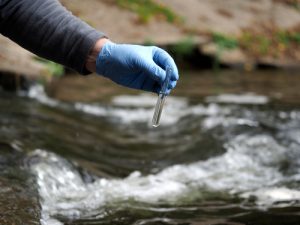
U.S. Rep. Fred Upton (R-MI) is championing congressional efforts pressing the U.S. Environmental Protection Agency (EPA) to strengthen federal drinking water safeguards against major contaminants.
The bipartisan call led by Rep. Upton follows release of an Agency for Toxic Substances and Disease Registry (ATSDR) report showing that man-made per- and polyfluoroalkyl (PFAS) chemicals, which are increasingly being found in drinking water nationwide, are more dangerous to humans than the EPA has previously acknowledged.
“While critical scientific inputs on PFAS are missing, the information that is currently out there is raising many public questions,” wrote Rep. Upton and U.S. Rep. Dan Kildee (D-MI) in a July 17 letter sent to EPA Acting Administrator Andrew Wheeler that’s signed by five other members.
“The EPA should move quickly to make appropriate changes to the existing drinking water health advisories that effectively communicate and explain risks to the public, as well as provide tools for adequate protection from exposure to these chemicals,” the lawmakers wrote.
Across the country, PFAS have been used since the 1950s in non-stick cookware, water-repellent clothing, stain resistant fabrics and carpets, some cosmetics, some firefighting foams, and products that resist grease, water and oil, according to the ATSDR.
In general, animal studies have found that animals exposed to PFAS at high levels resulted in changes in the function of the liver, thyroid, pancreas and hormone levels, according to ATSDR, which this month also reported that “studies do not clearly show whether PFAS cause cancer in people.”
The House members are particularly concerned about “the potential serious health issues that could result from exposure to PFOS and PFOA” — perfluorooctane sulfonate and perfluorooctanoic acid, respectively — which are two types of PFAS contaminants.
“We urge the EPA to review the final toxicological profile and, as appropriate, act immediately to adjust the health advisory levels for PFOS and PFOA,” according to the lawmakers’ letter.
In fact, according to ATSDR, people exposed to high levels may have increased risk of kidney cancer or testicular cancer, although the most-recent studies haven’t been consistent. “Studies in animals have shown that PFOA and PFOS can cause cancer in the liver, testes, pancreas, and thyroid,” the agency said this month. “However, some scientists believe that humans may not develop the same cancers as animals.”
The congressmen also have asked the EPA to create a recommended level for PFOA and another type of PFAS called perfluorohexane sulfonic acid (PFHxS).
The EPA has said that PFOS and PFOA have the highest production volumes in the United States and efforts have been made since 2000 to phase out their production, “however, the fact that some of these chemicals may be persistent in the environment and have a long half-life in humans means that they may continue to persist in the environment and in people for many years, despite reductions in emissions.”
The major sources of human exposure to PFCs may include food, water, indoor and outdoor air, breast milk, and dust, according to the EPA, and some have been widely detected in pregnant women and in umbilical cord blood, “suggesting that the developing fetus can be exposed.”
In their letter, the congressmen said the EPA’s current health advisory levels for PFOA and PFOS in drinking water – now set at 70 parts per trillion – could be seven to 10 times higher than what has been preliminarily identified in the ATSDR report as the minimal risk level for these chemicals.
“We urge you to work with ATSDR as you develop toxicity values, analytical methods, and treatment options on PFAS for states, tribes, local governments, and health professionals,” the members wrote.



